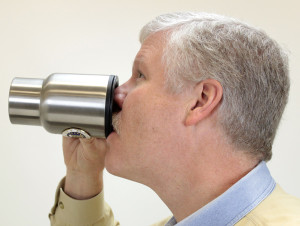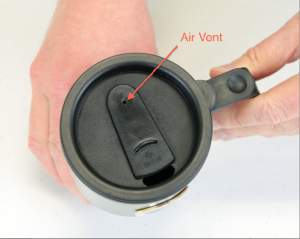 Sticking Your Nose Where It Doesn’t Belong!
Sticking Your Nose Where It Doesn’t Belong!
by Ted Beyer
At Educational Innovations, our management staff meets often to coordinate all of the goings-on here. All sorts of topics come up, both business related and science related.
More than two years ago, our Director of Operations, Ken Byrne, shared a story with us relating to his brand new travel-style coffee mug, which he had gotten as a gift. I am sure you have run into these things many times – an insulated vessel with a liquid/air-tight cap. The cap, of course, has a hole along one edge for you to drink your beverage.
The story was one of many great examples of air pressure in everyday life. It went like this –
He was trying to drink his coffee, but, every time he tried, nothing would come out. He kept thinking that he must be using his new mug incorrectly – perhaps he had missed an instruction or technique unique to this cup that was designed to help prevent spills or something. No, no, that could not be it — he could pour it out, easily enough, but whenever he brought it to his lips to drink – nothing…
Let me stop there for a moment – we’ll get back to Ken’s coffee in just a bit. But let’s talk air pressure for a moment. If you were to try and pour the liquid out of the nearly air tight container, only a small amount would actually exit before the flow stopped. Why? Air pressure. The liquid departing the container would increase the volume of the air trapped behind the liquid in the container, lowering its pressure. That means that the air pressure in the room surrounding the container would actually be pushing the coffee into the container and holding it in place.
If you use our SS-1 Tornado Tube, you can show this principle quite easily. Simply set the experiment up by filling one soda bottle ¾ of the way up with water (add some food coloring if you like), screwing on the tornado tube, and then screwing another, empty, soda bottle to the other end. Once you have everything assembled, just turn it over quickly, and let it sit. A little water will drip into the empty bottle now located on the bottom, but the vast majority of the water will stay trapped in the upper bottle, held there by the difference in the air pressure in the two bottles. The air at the very top of the stack is at a lower pressure than the air at the bottom of the stack.
At this point, if you were doing this in a classroom setting, you could challenge your students to a race – let them do whatever they want to get the water from the top bottle to the other – short of taking the assembly apart. Usually this will involve a lot of shaking and the like. The best and fastest way to do it is to simply swirl the entire assembly a bit to get the water to create a vortex.
If you look carefully, you will discover that the vortex is actually hollow – air is being allowed to flow between the bottles through the center of the flow, allowing the air pressure in the two halves of the assembly to equalize, and thus the water to flow freely.
Oh – it’s also really cool to watch, looks just like a tornado made of water – and is what gives the product its name. (Side note – it really is mesmerizing to watch – even if you don’t happen to be teaching air pressure!)
Incidentally, if you ever need to empty a large bottle full of a water-like liquid, this same swirling motion is, by far, the fastest way to do it. I use the technique from time to time when cooking large batches of things for gatherings.
Ok – back to Ken and his coffee problems:
Coffee cup designers are not without scientific knowledge. They understand this air pressure problem as well as anyone else out there, and they provide a tiny vent hole, usually 180 degree around from the drink hole to allow the air pressure to equalize and allow the caffeine supply to flow freely, thus making sure to keep our Director of Operations coherent.
So what is going on with Ken’s cup??
It took him a while to determine the cause of his coffee conundrum… It develops that the makers of this particular mug, fully aware that the cap would require an air vent, did in fact provide one. But instead of locating it on the edge of the lid, they located it closer to the middle of the lid. As fate would have it, the vent hole lined up perfectly with Ken’s nose! As a result, when he attempted to take a drink, his nose would touch the vent, thus creating a near perfect seal that prevented any air flow, and effectively imprisoning his coffee.
When he told this story, we all immediately recognized that it was a great basis for a blog entry! We all encouraged him to write it up, but Ken is not exactly rolling in free time. In light of that “I’m too busy” excuse (I just don’t think he wanted to do it, myself, but you be the judge), and in spite of the fact that I added a reminder to my manager’s meeting for more than a year, it never got written. Still, the anecdote seemed too good to let die – and so here we are. Let’s hope Ken’s “nose for news” leads to other good blogs!



Very well written, Ted. I really like your picture too.
Epic……
A-ma-zing!
wow such an amazing and informative article……thnx for the info….it has helped me a lot….
I was looking up examples of air pressure in daily life and I came across this…I couldn’t help laughing:33
Glad you liked it!
~Tami
Educational Innovations
Cooooooool
Great and thanks for the information.
I have a question. How come the pressure inside a container pushed by a pressure from out side by water come down slowly.
Thanks.
wow! amazing